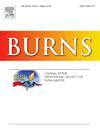Burn injury and fear of rejection: A qualitative study
IF 3.2
3区 医学
Q2 CRITICAL CARE MEDICINE
引用次数: 0
Abstract
Introduction
One of the most important duties of the members of the treatment team is to pay attention to the mental, psychological, and social aspects of burn patients. One of the concerns of these patients during their stay in the hospital is the fear of rejection. The objective of this research is to examine the concept of 'fear of rejection' among patients hospitalized with burn injuries.
Method
This study was conducted between January 2023 and March 2024 in Hamadan, Iran, employing a qualitative content-analysis approach. The study enrolled sixteen patients, and data were collected through deep and semi-structured interviews. The data were then analyzed using the conventional content-analysis approach developed by Graneheim and Lundman.
Results
A group of 16 patients, comprising an equal number of men and women, were interviewed for this study. Based on the data obtained from these interviews, negative brainstorming, frustration, fear of permanent physical disabilities, occupational and financial challenges were identified as categories; visualization of a foggy future and inability in performance of roles emerged as the two themes.
Conclusion
Based on the results of this study, it can be said that the fear of social rejection, characterized by an inability to perform roles and the visualization of a foggy future, significantly affects the psychological and physical health of burn patients, potentially delaying their recovery. Assisting these patients in reaching their fullest potential to contribute to society post-discharge, and fostering optimism for a promising future, constitute a paramount aspect of daily care and ongoing support.
烧伤和害怕被拒绝:定性研究。
导言:治疗小组成员最重要的职责之一就是关注烧伤病人的精神、心理和社交方面。烧伤病人在住院期间最担心的问题之一就是害怕被拒绝。本研究旨在探讨烧伤住院患者 "害怕被拒绝 "的概念:本研究于 2023 年 1 月至 2024 年 3 月在伊朗哈马丹进行,采用了定性内容分析法。研究共招募了 16 名患者,通过深度访谈和半结构化访谈收集数据。然后采用格拉内姆和伦德曼开发的传统内容分析法对数据进行分析:本研究共采访了 16 名患者,男女患者人数相等。根据访谈获得的数据,负面头脑风暴、挫败感、对永久性身体残疾的恐惧、职业和经济挑战被确定为类别;对迷茫未来的想象和无法履行角色成为两个主题:根据本研究的结果,可以说烧伤患者对社会排斥的恐惧、对无法扮演角色的恐惧以及对迷茫未来的恐惧极大地影响了他们的心理和生理健康,有可能延迟他们的康复。帮助这些患者充分发挥潜力,在出院后为社会做出贡献,并培养他们对美好未来的乐观态度,是日常护理和持续支持的一个重要方面。
本文章由计算机程序翻译,如有差异,请以英文原文为准。
求助全文
约1分钟内获得全文
求助全文
来源期刊

Burns
医学-皮肤病学
CiteScore
4.50
自引率
18.50%
发文量
304
审稿时长
72 days
期刊介绍:
Burns aims to foster the exchange of information among all engaged in preventing and treating the effects of burns. The journal focuses on clinical, scientific and social aspects of these injuries and covers the prevention of the injury, the epidemiology of such injuries and all aspects of treatment including development of new techniques and technologies and verification of existing ones. Regular features include clinical and scientific papers, state of the art reviews and descriptions of burn-care in practice.
Topics covered by Burns include: the effects of smoke on man and animals, their tissues and cells; the responses to and treatment of patients and animals with chemical injuries to the skin; the biological and clinical effects of cold injuries; surgical techniques which are, or may be relevant to the treatment of burned patients during the acute or reconstructive phase following injury; well controlled laboratory studies of the effectiveness of anti-microbial agents on infection and new materials on scarring and healing; inflammatory responses to injury, effectiveness of related agents and other compounds used to modify the physiological and cellular responses to the injury; experimental studies of burns and the outcome of burn wound healing; regenerative medicine concerning the skin.
 求助内容:
求助内容: 应助结果提醒方式:
应助结果提醒方式:


